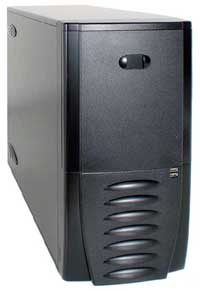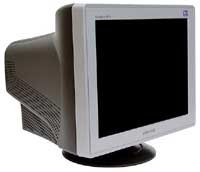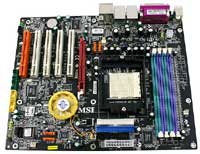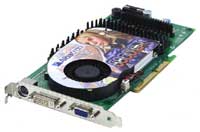AMD Mid-Range Gaming System
If you want some more
oomph in your system - say you like higher resolutions and antialiasing, or maybe you're a competitive online gamer - you could upgrade a few parts in the Budget System and end up with acceptable performance. We're going to kick it up another notch for the Mid-Range segment by improving nearly every component.
| Mid-Range AMD Athlon 64 System |
| Hardware |
Recommended Component |
Price |
| Processor |
AMD Athlon 64 3500+ 512K 2.2 GHz (939) 90nm |
285 |
| Motherboard |
MSI K8N Neo2 Platinum |
131 |
| Memory |
Mushkin Dual Pack 2x512 PC3200 2.5-3-3 |
159 |
| Video Card |
Albatron GeFORCE 6800 GT 256MB GDDR3 |
374 |
| Hard Drive |
Seagate 160GB SATA 7200RPM 8MB Model ST3160023AS |
93 |
| Optical Drive |
NEC DVD+/-RW Drive Model 3500A |
72 |
| Case and Power Supply |
Antec SLK3700-BQE with 350W |
91 |
| Display |
Samsung SyncMaster 997DF 19 CRT |
234 |
| Speakers |
Logitech Z-640 5.1 |
52 |
| Keyboard |
Logitech Internet Keyboard |
17 |
| Mouse |
Microsoft IntelliMouse Optical |
24 |
| Bottom Line |
|
1532 |

Click to enlarge. |
We return to several components that we have recommended in the past for the Mid-Range system. We've doubled the amount of RAM, and we've upgraded the case and PSU to the Antec SLK3700-BQE. It's not a flashy case, so if you're interested in that, you might look elsewhere. Nevertheless, it is a well thought out design, and the use of dual 120mm fans provides ample cooling when you add in the front fan. For the monitor, we have upgraded to a 19" CRT, which has the ability to run at 1600x1200 with a 75 Hz refresh rate. The NEC FE991SB is also an option, although it costs $40 more. We have upgraded to a Serial ATA hard drive with 160GB storage capacity, again staying with Seagate and their five-year warranty. Most of the other base components remain the same, although we opted for the five-button Microsoft IntelliMouse Optical this time.

Click to enlarge. |
The major changes come in the selection of motherboard, CPU, and graphics card. This should come as no surprise, as we have already mentioned several times that these are the most important aspects of a gaming system. For the processor, we have upgraded to an Athlon 64 3500+. The raw clockspeed advantage is not that great, but our
initial tests of the 90nm parts show a slight performance increase relative to the older 130nm 3500+, particularly in games, and it also has better overclocking capabilities if you're interested in that. The power use of the 90 nm parts is also substantially lower than the 130 nm design. The total price increase is $20 relative to the 130nm part, so either one is fine. The motherboard that we have selected uses the NForce3 250 Ultra chipset, and it was also our Gold Editor's Choice in our
Socket 939 Motherboard Roundup. There are several socket 939 motherboards with similar features that use the VIA K8T800 Pro chipset, but we have stuck with the NVIDIA chipset as tests have shown that it has a slight performance advantage when used with an NVIDIA graphics card compared to boards using the VIA chipset. ATI boards do not incur any penalties either, should you choose to go that route. If you prefer the VIA based boards, the Abit AV8 and Asus A8V both received our Silver Editor's Choice.

Click to enlarge. |
Speaking of graphics, our recommendation goes to a GeForce 6800GT AGP model. With 16 pixel pipelines, a 350 MHz GPU core and 1 GHz GDDR3 RAM, it provides nearly twice the performance of the 9800 Pro and significantly more than the 6600GT as well. Performance doesn't vary much if at all between the various manufacturers, so we have selected the card that we could find for the lowest price. You could also look into spending a bit more for a BFG 6800GT OC model that comes factory overclocked or the Leadtek model with it's larger two-slot HSF, but otherwise there is not a whole lot to differentiate among the designs. For ATI lovers, the X800 Pro actually offers very similar performance to the 6800GT. It only has 12 pixel pipelines, but since they're clocked at 475 MHz instead of 350 MHz, it ends up as almost a tie. The 6800GT has faster RAM - 1 GHz compared to 900 MHz - and it also includes Shader Model 3.0 support, not to mention a lower price. If you can find the X800 Pro for less than the 6800GT, though, it's definitely worth considering.

Click to enlarge. |
Then again, the AGP socket could become something of a limitation for upgrades by that time. We have recently previewed the
NForce 4 chipset as well as
ATI's RX480. Both should be available for purchase before the end of the year, and the NVIDIA boards will likely start showing up by the end of this month. If you're considering a socket 939 platform, and assuming you're willing to pay the price premium, it could be worth waiting for the PCI Express motherboards to ship. We'll take a look at PCI Express costs with our Intel Mid-Range alternative. SLI is also a very attractive feature for those looking to buy one card now and upgrade later. All told, an SLI-capable system will probably cost about $100 more than an equivalent AGP setup, but with AGP you're stuck with one graphics card.














70 Comments
View All Comments
JarredWalton - Sunday, November 21, 2004 - link
Xsilver - We really don't know when AGP will be fully phased out. It could be mostly gone in a year, or it could stick around for four more years. With NVIDIA's HSI bridge chip, they should be able to continue to support AGP as long as it's a reasonable market, and with dramatically faster processors more or less on hold for a year or so, I would expect AGP to continue to get support for at least two years. It might come a little later than the latest PCIe cards, but that's better than nothing.Regarding the choice of motherboards, right now I would have to go with the Abit or ASUS boards over the Gigabyte. Some people like Gigabyte a lot, but I'm not really one of them. The boards always seem to have issues - my one Athlon XP system with a Gigabyte board has constant "overheating" problems, even though temps never actually break 60 C. The motherboard *thinks* the CPU is running too hot. I've never been seriously disappointed by Abit or ASUS, so that's what I would take.
Moletus: the 6800LE is available, mostly in Europe, but short of unlocking the extra pipelines there's no real reason to go with it. The 6600GT is close in performance to the 6800, and the LE is going to have the same number of pipelines with a lower clockspeed. If you can't find the 6600GT, or if you want to take a chance on unlocking the extra pipelines, the 6800LE is worth a shot.
xsilver - Sunday, November 21, 2004 - link
Also some news on WHEN Agp is going to be phased out would be good.... are the next gen nvidia/ati products still going to be availble with AGP? if not, it would make sense to switch now?xsilver - Sunday, November 21, 2004 - link
I am considering the second AMD option -- want to know more about the choice of motherboardsWhere I am, only the abit, asus a8v and gigabyte "Gigabyte GA-K8NS Ultra-939" are abailable which is nf3 based...
I've heard good things about the nf3 but bad things about this particular gigabyte board.... is the abit still the way to go? the gigabyte is actually the cheapest though... marginally
The MSI nf3 is also availble but is $45 more..
Is the abit going to be the most stable with the best ability for good overclocks?
And on stock cooling/voltage how much could be extracted out of the 3000+ / 939? is 2.4ghz guaranteed?
thebluesgnr - Sunday, November 21, 2004 - link
This guide bothers to add an option for those who want an Intel processor because there are AT readers that prefer Intel platforms (processor+chipset), even knowing gaming performance is a little better on AMD.I'm not one of those readoers though ;)
Pollock - Sunday, November 21, 2004 - link
I assume stock cooling for all processors......but what about the OEM 3000+? $140 at Monarch...
moletus - Sunday, November 21, 2004 - link
You really cant blame Intel only machines for stability problems. (just finished playing hl2 with p3-800 and ati 8500, and no im not a masochist) And on the long run i think Intel boxes will outlive any Amd counterpart, and yes i would buy Amd too :)MAME - Sunday, November 21, 2004 - link
oh, the only thing I am curious about is why even bother putting the Intel counterparts in there in the first place? AMD has the clear advantage over Intel in gaming. Since Intel's offerings are more expensive and perform worse, I really don't see a reason to go that route.moletus - Sunday, November 21, 2004 - link
Hey where is 6800le ? i havent seen a single thing about it, even thou you can buy one.. atleast in europe, no benchies no nuttin :( i woulda bet that beats any price/performance ratio when you get those pixel pipes running (with luck:)MAME - Sunday, November 21, 2004 - link
prepare to be bombarded by everyone who thinks they can save $2 and build a much better riganyway, looks pretty decent to me
Christian Fitchett - Thursday, February 20, 2020 - link
It’s really difficult to choose a new game, it requires incredible efforts because you want to buy them all. I think this guide will help the game buyer to decide and make their choice. I, too, can help you identify only in another area, in education. I can help you with essay writing at this website https://paperell.com/ , you just need to visit this service, where I can help you or advise you.